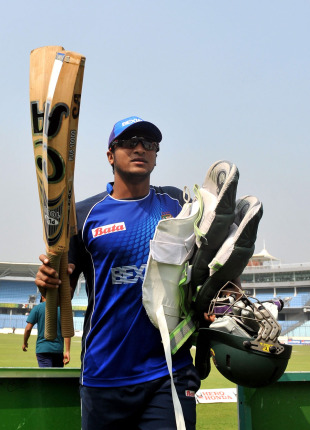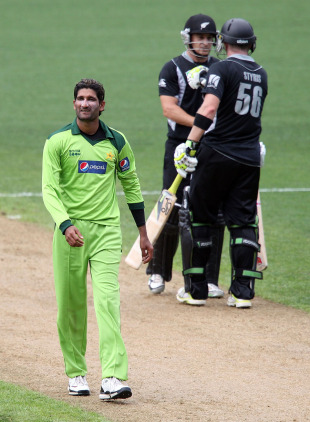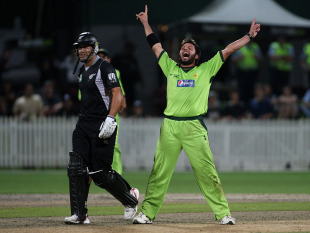
Match Facts
February 19, Mirpur
Start time 14:30 local time (08:30 GMT)
Big Picture
Events unfolding in Port of Spain four years ago culminated in euphoria on one side of the Bengal border, and gloom on the other. With every dance down the wicket from Tamim Iqbal, little-fancied Bangladesh landed another blow in a series of blows that would eventually eliminate India, wearied by the weight of expectation and a discordant dressing room, from the first round of the World Cup. Four years later the teams meet again, but in a tournament protected from the domino effect of a shock like the one in Trinidad. The stakes this time are different as well, for it is not just India, overwhelming favourites again, who carry a tremendous weight of expectation.
As Shakib Al Hasan entered the opening ceremony in a decorated cycle rickshaw, soaking in the goodwill from tens of thousands inside the Bangabandhu Stadium and the crowds surrounding it, his demeanour revealed pride and a sense of the grandeur of the occasion, and none of the reluctance he's had in captaining Bangladesh in series past. There would also have been a feeling of responsibility, of a magnitude no Bangladesh captain has ever faced before.
For the first time, Bangladesh are expected to go beyond the first round of a World Cup. For the first time, and largely because of a significant home advantage, their passage will not be considered an upset. For the first time, they are hosting a World Cup and can see all around them a stirring passion saturating the country. Bangladesh too will be relieved that the format allows a little room for error, while striving to avoid it against one of the tournament heavyweights.
Justifiably or not, India have begun several World Cups wearing the favourites tag, but never has that label been more authentic than now. Their bowling attack might blow hot and cold, but even on their most frigid days India possess a batting line-up capable of overhauling anything. And they play all their matches on the familiar pitches of home, apart from the opener against Bangladesh, which is at the Shere Bangla Stadium in Mirpur. The Indians won't say that revenge for 2007 is on their minds but there is no chance they will go into the contest with an iota of complacency.
Form guide
(Most recent first)
Bangladesh: WWWLW
India: LLWWL
Pitch and conditions
The pitch used for the practice game between Bangladesh and Pakistan in Mirpur had turn for the spinners. Not much is known about the surface for Saturday but it is expected to aid the slow bowlers. Dew has traditionally had an impact on day-night fixtures in Dhaka but it is supposedly not as big a concern in February. However, this is what Waqar Younis, Pakistan's coach, said after the warm-up game: "There was a little bit [of dew], maybe in the last 15 overs. It can be trouble later on in the tournament, so good luck to whoever is playing here."
Watch out for…
India's batsmen: Sehwag, Tendulkar, Gambhir, Kohli, Yuvraj, Dhoni and Yusuf. The weakest link on paper in that line-up, Virat Kohli, is also India's most in-form batsman. And Suresh Raina, who was a rabbit in South Africa but is a force on the subcontinent, is an option too. Each one is capable of producing a match-winning innings. This Indian side is calibrated for scoring a 300-plus total, and chasing one down.
Spin, and dew: In their last ODI at home before the World Cup, against Zimbabwe, Bangladesh played four spinners: specialists Abdur Razzak and Suhrawadi Shuvo, allrounder Shakib, and part-time offspinner Naeem Islam. On slow tracks that turn, with batsmen needing to create the pace, they can control the pace of the game. India have played just one specialist, Harbhajan Singh, in recent games and relied on a phalanx of able part-timers - Yuvraj Singh, Yusuf Pathan and Suresh Raina. Given the prominent role of spin, the dew in Mirpur, if it is heavy, could have a considerable role in the day-night contest. A slippery ball and a slick outfield will be a disadvantage for the team defending a target under floodlights.
A fever-pitch atmosphere: The build-up to the World Cup has visibly been more intense in Bangladesh than in either India or Sri Lanka. The excitement reached a crescendo in the hours before the opening ceremony and it is poised to spill over when the opening game gets underway. India rarely play in front of a crowd in which they have virtually no support. That is likely to happen tomorrow. If Shakib's men are looking for a little more inspiration, they will hear it reverberate around the Shere Bangla.
Team news
There was a fitness concern over Shafiul Islam, who bowled only five overs in the warm-up against Pakistan, but he is expected to be fit. Raqibul Hasan could make the XI ahead of Mohammad Ashraful and Bangladesh could also play two spinning allrounders in Mahmudullah and Naeem Islam.
Bangladesh (probable): 1 Tamim Iqbal, 2 Imrul Kayes, 3 Junaid Siddique, 4 Mushfiqur Rahim (wk), 5 Raqibul Hasan 6 Shakib Al Hasan (capt), 7 Mahmudullah, 8 Naeem Islam 9 Abdur Razzak, 10 Shafiul Islam, 11 Rubel Hossain.
After sitting out of both of India's warm-up matches with a groin niggle, Zaheer Khan bowled during India's net session and will lead the attack on Saturday. The major decision India will have to make is whether to play Kohli or Raina. Kohli has been in excellent form, but an extra left-hander, Raina, could be useful in combating Bangladesh's left-arm spinners. Dhoni, however, had indicated a few days ago that Kohli could edge Raina out.
India (probable): 1 Virender Sehwag, 2 Sachin Tendulkar, 3 Gautam Gambhir, 4 Virat Kohli/Suresh Raina, 5 Yuvraj Singh, 6 MS Dhoni (capt & wk), 7 Yusuf Pathan, 8 Harbhajan Singh, 9 Zaheer Khan, 10 Ashish Nehra, 11 Munaf Patel.
Stats and trivia
Mirpur is easily Bangladesh's most successful ODI venue - they've won 18 matches here, which is three times the number they've won at their next-best venue. They've won 64 games in all, which means 28% of their ODI wins have come in Mirpur.
The last 12 day-night matches in Mirpur have all been won by the team batting second. Overall, in 16 day-night ODIs, the team batting first has won only three times.
India have won seven and lost three ODIs in Mirpur, but they've beaten Bangladesh in all five matches here. Three of those were day-night games, and in all of them India chased.
Most of India's top order has done well in Mirpur, with Gambhir, Dhoni, Kohli and Raina all averaging more than 50, and scoring at least one century here. For Bangladesh, Shakib and Tamim have scored two hundreds each in ODIs at this venue.
Quotes
"The guys have played enough cricket to cope with the pressure. We are not looking too far ahead. We will take it one game at a time and concentrate on the job at hand. I don't think it can get better than this. Playing a strong side like India has its advantages. We want to prove ourselves against the best."
Shakib Al Hasan on the eve of the beginning of Bangladesh's World Cup campaign.
"Being a co-host will always bring a lot of expectations. But we do not get bogged down by expectations. The important thing is to do the process right. We always look to put more emphasis on the process, rather than on winning, and this is what has made us a successful team."
MS Dhoni attempts to cocoon his team from the hype around India's chances at the World Cup.

























